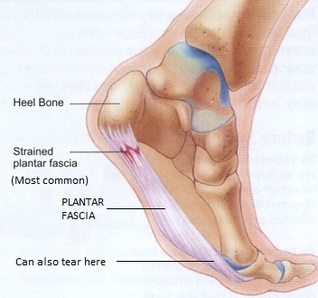Plantar Fasciitis/ Heel Spur Syndrome

What is plantar fasciitis?
Plantar fasciitis is inflammation of the plantar fascia; a band of thick, inelastic, fibrous connective tissue that runs deep in the bottom of the foot. It begins at the bottom of the heel bone and runs up to the ball of the foot. At the back of the heel bone, the plantar fascia connects with the Achilles tendon. Over time, the fascia tears microscopically and becomes inflamed. During rest, the body tries to heal the torn fascia and the pain may subside. Once standing and walking on the injured foot begins, the fascia re-tears and pain is felt. Plantar fasciitis associated heel pain is often described as a sharp stabbing sensation under the heel bone and/or under the ball of the foot. The pain is often the worst on the first steps out of bed, or after a long period of rest, and improves with walking. As the plantar fasciitis becomes worse, the pain may become constant and occur during walking.
Why do I have plantar fasciitis?
The role of the plantar fascia is to support the muscles, ligaments and bones of the arch. Plantar fasciitis is caused by excessive strain placed on the plantar fascia. This can be due to foot structure (high or low arches), long periods of weight bearing, shoes without adequate support, high body mass, and athletic activity.
What is a heel spur?
A heel spur may be associated with plantar fasciitis. When the micro tears in the fascia occur at the heel bone, inflammation of the bone causes new bone to form, called a spur. A heel spur is not painful and is the secondary result of inflammation in the plantar fascia. Removing a heel spur will not necessarily remove pain. Even without the spur, the underlying inflammation in the fascia will remain.
How can a Chiropodist help?
A Chiropodist will perform several assessments to determine the cause of the plantar fasciitis, they can provide information on footwear that will help decrease the over stretching of the fascia, they can prescribe a custom foot orthotic, provide a stretching regimen, prescribe
anti-inflammatory medication, give instructions on modifiying activity, perform physical therapy such as ultrasound therapy, perform athletic taping of the foot, and give corticosteroid injections if warranted.
The information provided is intended for educational purposes only. It is not a substitute for a proper medical evaluation. Treatment options will vary from person to person.
Plantar fasciitis is inflammation of the plantar fascia; a band of thick, inelastic, fibrous connective tissue that runs deep in the bottom of the foot. It begins at the bottom of the heel bone and runs up to the ball of the foot. At the back of the heel bone, the plantar fascia connects with the Achilles tendon. Over time, the fascia tears microscopically and becomes inflamed. During rest, the body tries to heal the torn fascia and the pain may subside. Once standing and walking on the injured foot begins, the fascia re-tears and pain is felt. Plantar fasciitis associated heel pain is often described as a sharp stabbing sensation under the heel bone and/or under the ball of the foot. The pain is often the worst on the first steps out of bed, or after a long period of rest, and improves with walking. As the plantar fasciitis becomes worse, the pain may become constant and occur during walking.
Why do I have plantar fasciitis?
The role of the plantar fascia is to support the muscles, ligaments and bones of the arch. Plantar fasciitis is caused by excessive strain placed on the plantar fascia. This can be due to foot structure (high or low arches), long periods of weight bearing, shoes without adequate support, high body mass, and athletic activity.
What is a heel spur?
A heel spur may be associated with plantar fasciitis. When the micro tears in the fascia occur at the heel bone, inflammation of the bone causes new bone to form, called a spur. A heel spur is not painful and is the secondary result of inflammation in the plantar fascia. Removing a heel spur will not necessarily remove pain. Even without the spur, the underlying inflammation in the fascia will remain.
How can a Chiropodist help?
A Chiropodist will perform several assessments to determine the cause of the plantar fasciitis, they can provide information on footwear that will help decrease the over stretching of the fascia, they can prescribe a custom foot orthotic, provide a stretching regimen, prescribe
anti-inflammatory medication, give instructions on modifiying activity, perform physical therapy such as ultrasound therapy, perform athletic taping of the foot, and give corticosteroid injections if warranted.
The information provided is intended for educational purposes only. It is not a substitute for a proper medical evaluation. Treatment options will vary from person to person.
